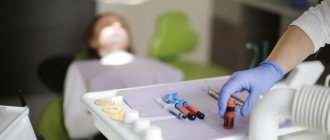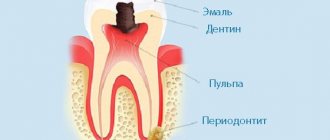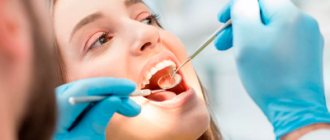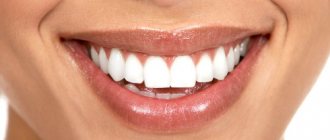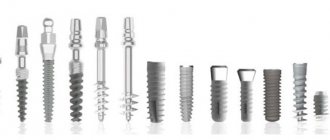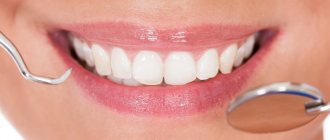Dental treatment is a medical procedure that corrects a smile, corrects imperfections and relieves pain. However, discomfort after dental surgery, in particular after installing a filling, does not go away immediately.
In 90% of cases, mild pain is natural, since the filling affects nerves, canals, and tissues. It takes time for the filling to “take root”. During this period, the pain can be constant, fading or variable, provoked by irritants: hot tea, strong pressure on the gums, etc.
But there are other pains - pathological ones. They require new medical intervention and careful treatment. Let's consider each option in more detail.
What can cause a tooth to hurt when pressed?
There are many reasons why a tooth hurts when pressed. This could be a tooth injury, a consequence of inflammatory processes, incorrect tooth installation, or even a crack in the crown. Only a doctor can determine the original source of pain.
Therefore, you should not wait for the pain to spread throughout the gum - if we are talking about purulent infections, it can lead to gumboil, further surgical intervention and tooth extraction. Pain in such cases can cover almost the entire head, radiating to the ear, temple, and submandibular region.
Caries
The most common cause of pain when pressing is caries. At the initial stage, the disease is asymptomatic, but at the stage of medium and deep caries, the tooth can react when pressed, and quite strongly. Gradually, the pain can turn from shooting into aching, then into throbbing, and this is already pulpitis.
Recommendations: go straight to the dentist. If pain manifests itself, it means that the process of tissue destruction proceeds non-stop and very quickly.
Post-filling pain
After filling, the tooth may hurt, especially if the periodontal damage was deep. Soreness can be felt for up to three to four days, gradually decreasing. This is normal, since during treatment, in any case, trauma to the tooth tissue occurs. If the pain under the filling does not go away and even intensifies, the tooth will have to be opened and possible errors eliminated.
Another option for post-filling pain is a filling that is too high. When biting, the upper teeth actively press on the lower teeth with great force. In this case, the excess layer of filling composition can act as a provoking factor - the tooth may crack along the root, in which case the broken off part or even the entire unit will have to be removed. An experienced doctor will repeatedly check the height of the filling and find out from the patient how comfortable he is.
Tooth hurts under the crown
If the tooth under the crown begins to react when pressed, it will have to be removed in any case. The best option is if the exposed (ground down) dentin begins to react to the movement of air or food penetrating through a chip or crack. In this situation, it is enough to replace the crown.
It is much worse if inflammation of the periodontal or periodontal tissues has already begun. If the condition is neglected, periodontitis and the formation of cysts and granulomas may occur. Only a dentist can help you.
Untimely crown replacement can also cause tooth inflammation. Over time, worn-out material becomes the habitat and development of pathogenic flora, leading to the occurrence of inflammatory processes.
Important
. Inflammation under the crown can develop catastrophically quickly.
Pulpitis was not treated
If the tooth reacts to pressure after canal filling, there is a high probability that the nerve was not completely removed. Painful pressure (two to three days after removal of the nerve) indicates the onset of inflammation, which spreads first to the root of the tooth, and then to the gum tissue and periosteum.
A sealed tooth quickly becomes a source of severe pain - the resulting pus puts pressure on the nerve and “looks for a way out” to the side. If measures are taken in time, it will be possible to get by with therapeutic measures. Otherwise, the pain when pressed becomes unbearable in a short time, begins to pulsate, radiates to the temple, eye, ear on the affected side. Flux is formed - here it is impossible to do without the intervention of a surgeon.
The tooth darkens and hurts
One of the possible causes of pain when biting is incomplete treatment. Cavities form inside the dentin, and externally we notice that the tooth has darkened. This condition can become chronic, but at a certain point, when immunity decreases, an exacerbation may begin. Therefore, doctors recommend not delaying your trip to the dentist.
If there is inflammation
In other words, periodontitis. The first sign is severe pain when pressing. The disease is an inflammation of the bone tissue of the jaw, and can be considered as a natural complication of chronic pulpitis and deep caries. It is almost impossible to touch the gum and tooth. The pain is localized in the area of one tooth. Flux occurs very quickly, so a trip to the doctor is planned immediately after the first pain appears.
One of the signs of periodontitis is the appearance of false sensations. It begins to seem that the tooth is loose and even rises above the dentition. But the prevailing symptom is still unbearable pain. Periodontitis is accompanied by swelling and redness of the gums, body temperature rises, chills and weakness occur. The whole body suffers (and very much).
Important
. With periodontitis, the consequences are terrible - the formation of abscesses of various etiologies is possible, the worst option is the occurrence of osteomyelitis of the jaw bone.
Medicinal periodontitis
Diagnosed due to improper treatment. The tooth will need to be re-treated. Unfortunately, it is difficult to insure against this. But only a doctor can determine the exact cause.
Traumatic periodontitis
One of the symptoms of traumatic periodontitis is also pain when biting. It occurs not only as a result of blows from the outside (for example, with a ball, fist), but also when eating solid food. Alternatively, it is diagnosed quite often in those who like to chew nuts and seeds.
The tooth does not have to wobble. For infection to penetrate, microcracks in the enamel or minor chips are enough.
Important
. Traumatic periodontitis often occurs on the front teeth, which bear the main load when biting.
Wisdom tooth hurts
If you feel pain when pressing on a wisdom tooth, this may indicate that it has not yet fully erupted - the gums, if disturbed, immediately begin to react and hurt. Another reason is the entry and stagnation of food debris and saliva into the so-called hood, the fold of the gum above the tooth. The onset of inflammation causes this pain.
Another factor, perhaps the simplest and most explainable, is caries damage. Of course, we go to the doctor.
Important
. The main difference between the pain characteristic of a wisdom tooth is that it can put pressure on nearby molars. Accordingly, the nature of the pain changes - very quickly it begins to seem that the entire row of teeth hurts.
Dead tooth reacts
If you find that biting on a dead tooth causes pain, make plans to visit the dentist immediately. The sooner you do this, the fewer problems you will have. You will have to take a picture - only if it is available, the doctor will be able to determine the cause of the ailment.
Most likely, the tooth will have to be opened and the canals additionally cleaned. If necessary, the doctor will prescribe treatment with antibiotics, rinses, and physical therapy. Timely treatment will prevent the formation of cysts and granulomas.
A tooth hurts under an old filling: when do you need help from a dentist?
If the pain does not subside, you cannot do without a visit to the clinic. To make a correct diagnosis, the dentist needs to know all the symptoms associated with pain. The further method of treatment depends on the condition of the teeth and adjacent tissues. As a rule, the previous filling is removed, treated with antiseptics, and the canals are cleaned and sealed again.
After dental surgery, it is imperative to follow the doctor’s recommendations. They speed up the healing process and prevent new inflammations from developing. After applying the filling, it is not recommended to drink alcoholic beverages or excessively hot or cold food. Avoid sweets and solid foods. For the first two days, it is recommended to eat only soft foods and rinse your mouth after eating. Chew on the opposite side of the filled tooth for three days. You should brush your teeth gently and without pressure.
Even if the pain was there but has subsided, you should not postpone your visit to the clinic. Inflammatory processes may continue, and the pain will certainly return with even greater force.
Why can a healthy tooth hurt?
It turns out that an apparently healthy and intact tooth can also respond to pressure. Traditionally, this occurs with thin and sensitive enamel. Pain can occur not only with pressure, but also under the influence of hot, cold, sour, sweet.
In this case, doctors recommend using special gels and pastes that help strengthen the enamel. For particularly sensitive teeth, it is necessary to use therapy - professional fluoridation of the enamel, remineralization or additional filling.
A wisdom tooth can also react to biting - during the period of eruption, as well as during inflammation of the hood (gum fold). Food particles accumulate inside the pocket, which causes a purulent process. Quite often, the figure eight puts pressure on the adjacent molars, and they may feel numb.
The child has
A sharp pain when biting appears if the baby tooth begins to wobble. Everything is simple here - we wait until it falls out on its own or, after a little while, we go to the doctor. In such situations, both the upper and lower teeth may react.
What complications may arise?
The ultra-thin enamel can wear away over time. Dentin becomes vulnerable to the action of pathogenic microflora, rapid caries and inflammatory processes of the gums and bone tissue occur.
Important
. One of the reasons for pressure sensitivity is exposed tooth roots, the primary sign of incipient periodontal disease. And this is a completely different and very serious story.
Experts' opinion
The effectiveness of the ASEPTA series products has been proven by multiple clinical trials conducted in the country's leading research institutes.
For example, a study of the clinical effectiveness of treatment and prophylactic agents from the Asepta line in the treatment of inflammatory periodontal diseases, conducted by A.I. Grudyanov, I.Yu. Alexandrovskaya, V.Yu. Korzunina in the Department of Periodontology of the Central Research Institute of Dentistry and Maxillofacial Surgery of Rosmedtekhnologii, Moscow, made it possible to identify the fairly high effectiveness of the Asepta gum balm and the Asepta mouth rinse for moderate periodontitis. The use of Asepta mouth rinse for inflammation also turned out to be quite effective. In addition, no phenomena of mucosal irritation or brown staining of fillings were recorded. This indicates that the use of this rinse for a two-week period provides an obvious clinical effect in the absence of negative side effects.
Why might a tooth hurt after treatment?
What to do if, after treatment of a tooth, the tooth hurts when pressed - an unpleasant situation when you have already experienced the fear of visiting the doctor, the freeze has been released and suddenly discomfort arises again. Your actions depend on the specific situation and the cause of the pain.
They put a filling
Similar sensations may occur after treatment of medium and deep caries. A damaged tooth may respond to pressure two to three days after filling. Gradually the pain decreases and disappears.
Nerve removed
A pulpless tooth almost always hurts when biting. If you put medicine in a tooth (with arsenic or another active ingredient), the patient may experience discomfort for some time, even severe aching pain. Take an analgesic and it will feel a little better.
After cleaning the canals, the doctor places a temporary filling. After a few days, if there is no pain, it is changed to permanent. A sealed tooth without a nerve will react to pressure for several days. With proper treatment, the pain will gradually subside.
In particularly difficult cases of pulpitis, the neighboring teeth next to the patient also react to pressure. The false sensation disappears within one to three days after filling.
They put a pin
A tooth with a pin can also respond to pressure. In this case, the more massive the pin, the stronger the feeling of slight tension will be felt. When biting, the tooth will respond with slight pain for some time, but soon everything will return to normal.
Hurts under the bridge
If the treated tooth under the bridge is sick, most likely the dentin under the crown has become inflamed. The bridge will have to be removed and an x-ray will be required. Based on the results of the image and examination, the dentist will make the necessary decision.
Pain under crowns is dangerous because the situation may not be limited to caries. It is likely that there will be internal abscesses on the bone tissue, even leading to the occurrence of periodontitis.
Increased tooth
An extended tooth may also react to pressure with pain. Usually in such situations, part of the wall remains, the rest of the space is filled with filling material. Disturbed dentin causes concern for some time, but if the tooth is done correctly, the sensation goes away very quickly.
Cost of implant
There are special sensations here. Installing an implant is actually a full-fledged operation, after which you need to follow a certain regime. Subsequently, a crown is placed on the established rod and fixed. Pressure may cause minor pain.
Pain under old filling
It is not uncommon for a tooth to hurt when pressed under an old filling. In these cases, several options are possible - the filling has begun to deteriorate, and infection has opened up. Another option: in the case of a healed tooth, if the immune system fails, inflammation may occur in hard and soft tissues.
Important
. The rarest, but possible, cases are the instrument breaking and its pieces getting into the body of the tooth. Nothing depends on the patient here; all responsibility lies with the doctor.
Allergic pain reactions
In rare cases, the injected filling materials can cause an allergic reaction in the patient, which then causes toothache. Such allergies are very rare today, since holes are rarely filled with amalgam (the professional name for one of the filling materials whose properties take advantage of the ability of mercury to dissolve certain metals), but rather with modern light-curing composite filling materials.
What to do?
If a tooth hurts when pressed, we immediately make an appointment with a doctor without waiting for complications. There is no point in being afraid, since the problem will not be solved by itself, but you will still have to go. If you come on time, the tooth can be saved. The doctor will carry out all manipulations through the opened canal without surgical intervention.
If you delay going to the doctor and you develop swelling of the gums, an abscess or gumboil, you will have to cut the gum, remove the affected tissue, and install drainage. In the most severe cases, the tooth is removed.
To relieve pain and side effects, the doctor will prescribe rinsing with chlorhexidine, solutions of faracilin, and soda. If necessary, you will have to take a course of antibiotics and drugs that promote tissue regeneration.
Treatment at home
What can you do before visiting a doctor? If the pain begins to bother you greatly, you can take any of the medications you have at home - analgin, tempalgin, pentalgin, nimesil, paracetamol. It should be remembered that it is not recommended to drink these medications in large quantities, and some of them have a negative effect on the liver.
You can rinse your mouth with a solution of soda (one teaspoon per glass of water) or infusions of any anti-inflammatory herb that you have in the house - chamomile, sage, calendula, oregano. Decoctions are prepared traditionally; one tablespoon of the herbal mixture is poured with a glass of boiling water. Use warm.
What not to do
The first thing you absolutely cannot do is heat the sore spot. Inflammation may intensify, swelling and tissue pressure on the nerve will increase. The pain will very quickly become unbearable.
It is also not recommended to apply cold objects - ice or a piece of frozen meat, as this will only make things worse.
Do not attempt to open the tooth yourself. You are unlikely to succeed, but you can break it with almost a 100% guarantee. This means that after treatment you will have to go to prosthetists.
Important
. Uncontrolled use of antibiotics without a doctor's prescription is excluded.
Prevention
You will greatly help yourself if you practice good hygiene regularly. They are extremely simple - brush your teeth twice a day, rinse if necessary.
Visit your dentist for checkups twice a year. With this type of examination, the doctor will certainly notice in time possible troubles - beginning caries, crumbling old filling.
Get your teeth professionally cleaned. This is especially true for those who are prone to stone formation and who have been diagnosed with periodontal disease or periodontitis.
Gums can also cause toothache
Tooth decay is not always the cause of tooth pain, as the soft tissue can also become inflamed and cause pain. In particular, older patients are more likely to suffer from periodontitis, which, if left untreated, not only becomes increasingly painful, but can also lead to the loss of healthy teeth. Because if gingivitis is not treated professionally, the gums may recede further and thus expose the neck of the tooth. This not only increases the risk of tooth decay, but also increases the sensitivity of the teeth to pain, since the necks of the teeth are not surrounded by a protective layer of enamel.
Periodontitis, if detected early, can be well treated to keep gums healthy for a long time, but the patient also needs to improve their oral hygiene. The first major warning sign is blood on your toothbrush. If you spit reddish foam into the sink after brushing your teeth, you should make an appointment with your dentist to find out why. Even though gingivitis is often painless at first, in advanced stages it can cause significant pain and be much more difficult to cure.


